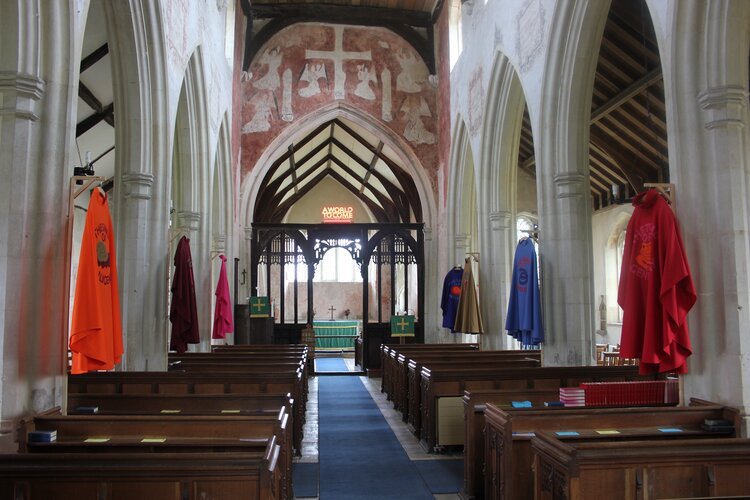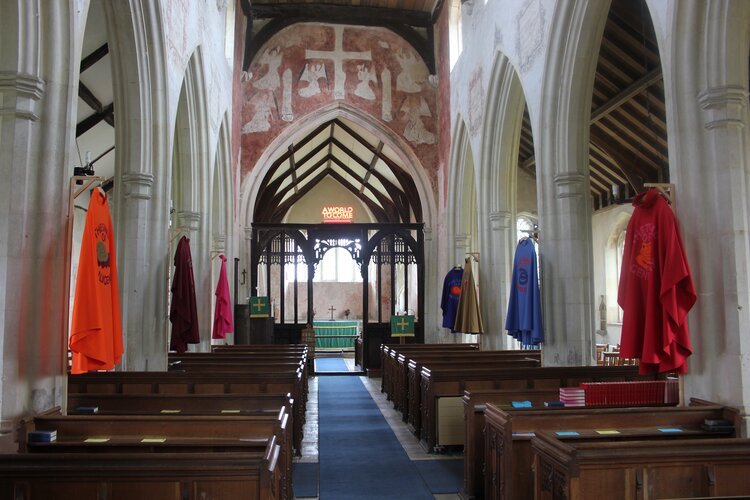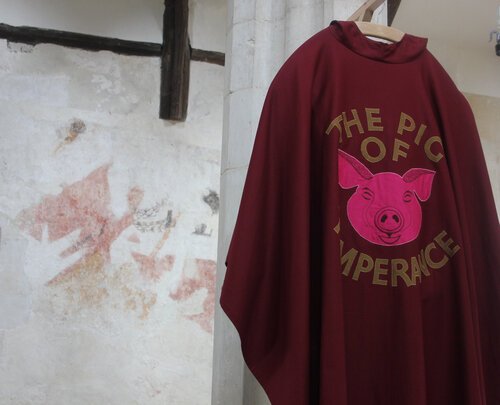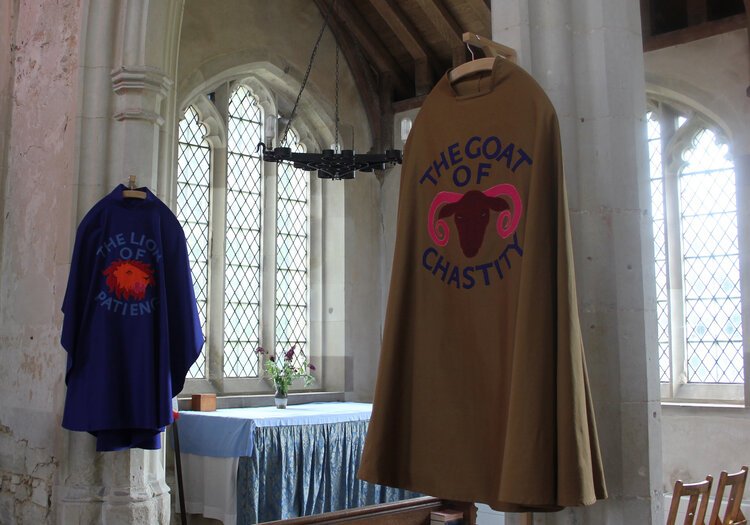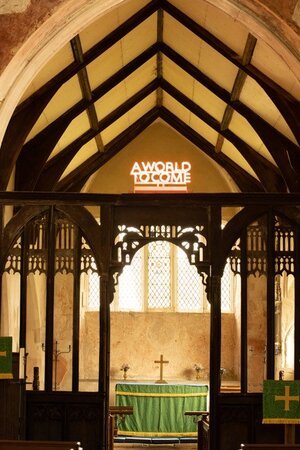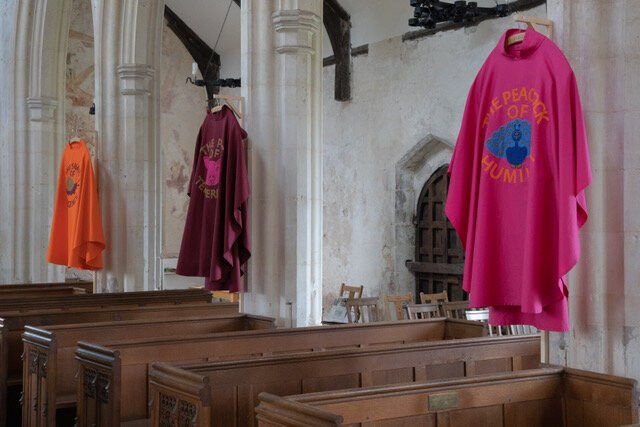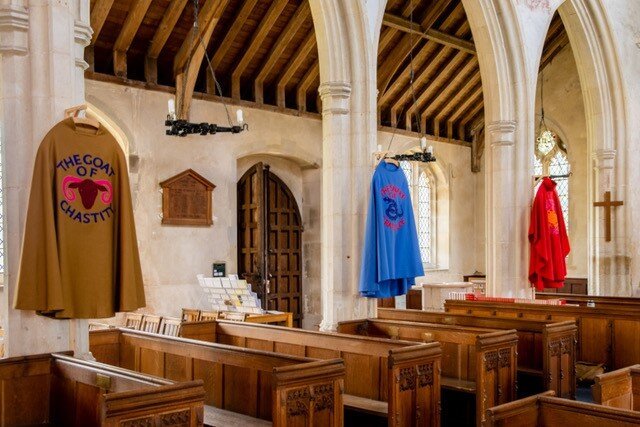A World To Come: Bettina Furnée
Artist: Bettina Furnée
Date: 13 July – 1 October 2019
Location: All Saints and St Andrew, Kingston
Summary
This project was a single artist, site-specific commission at All Saints and St Andrew, Kingston. Artists based at nearby Wysing Art Centre’s studios were invited to propose new work in response to a brief which called for the selected artist to respond directly to the historic wall paintings within the church. The artist, Bettina Furnée, was selected for her playful proposal which reflected on the theme of the battle between good evil depicted across a number of Kingston’s wall paintings. A key aim of the project was to demonstrate the churches’ enthusiasm for interpreting its history in engaging ways for a broad audience; the roof in need of repair, it was hoped that the project would help to support an HLF application. The project was also intended to draw attention to the multi-layered history of the church, encouraging people in nearby Cambridge and beyond, few of whom knew of the wall paintings, to visit, as well as casting a new light on the church for locals and members of the congregation.
Context
An ambition of the current Art in Churches programme (begun in January 2018) was to realise a project in a rural church, in recognition of the fact that rural churches face particular challenges due to their less accessible locations. Kingston is a village of around 220 people in rural Cambridgeshire. At its centre is All Saints and St Andrew, which was built primarily in the 13th and 15th Centuries.
Initial conversations with the Ely DAC Secretary, Sue Dickinson, and with Kingston’s Clerk of Works, Torrie Smith, about commissioning an artist revealed that the church was hoping to apply for HLF funds in 2018 in order to repair the roof, and that they were already thinking about ways in which the wall paintings might fulfil the HLF requirement to interpret the heritage of the building in new ways.
The church’s wall paintings date from the 13th to 17th Centuries, with the earliest located in the chancel where a figure believed to be a saint appears opposite two knights in battle. It is thought that this scene represents a Psychomachia; a battle between the virtues and vices inspired by Roman poet Prudentius epic poem. The chancel was also home to Kinston’s anchoress, who lived in a cell built into the walls. In the north aisle is a depiction of the Wheel of the Seven Acts of Corporal Mercy and, nearby, an image of the Tree of Evil attended by a figure of a horned devil.
Description
The project to commission an artist was formally approved by A+C’s trustees and Janet Berry from the Church Buildings Division of the Church of England, who partnered on the project, on the basis of a proposal by A+C’s Project Curator which was arrived at following conversations with All Saints and St Andrew’s small management team. Torrie Smith remained the primary contact from Kingston, while Team Rector Rev’d Nigel di Castiglione was part of a larger ‘project team’ which met to review progress on the commission at pivotal moments as well as corresponding via email. Initial conversations established that a temporary work by a contemporary artist would be commissioned, responding to the wall paintings in All Saints and St Andrew.
The parish expressed that they would like to work with a single artist rather than a group of artists, and decided that they would like to offer the commission exclusively to artists based at Wysing Arts Centre in nearby Bourne due to the skill and expertise of the artists working there as well as the proximity, which would support sustained engagement with the church.
Following a round of studio visits by Torrie Smith and A+C’s Project Curator to artists based at Wysing, three artists were asked to submit a proposal: Fiona Curran, Bettina Furnée and Caroline Wendling. A judging panel comprising representatives from the church, A+C and the Church of England selected Furnée’s proposal on the basis of its quality, and for its close attention to the brief which specified focus on the wall paintings.
Inspired by the depictions of the Seven Acts of Corporal Mercy on the church walls, which were originally ‘balanced’ by depictions of the Seven Deadly Sins (since lost) Furnée proposed to produce seven wearable robes, each with a unique design appliquéd on the front, and a neon text piece. The designs for the robes unify the Seven Deadly Sins - symbolised by animals - with their corresponding Seven Contrary Virtues, in a single image. These composite symbols draw on the tradition of symbolising virtues and vices with animals, which includes an example of a medieval illustrated manuscript of the Psychomachia which depicted vices and virtues riding on animals, with Pride on a lion, Anger on a bear, and so on. In response, Furnée’s designs include ‘the peacock of humility’ and ‘the toad of generosity’ in order to reflect on the limits of binary oppositions, the chasubles contend that we do not come equipped with virtues only. Furnée also challenges our cultural history of deploying animals to signify particular concepts or qualities, often undesirable ones.
Alongside the robes, Furnée proposed a neon text piece reading ‘A World to Come’ is presented alongside the chasubles. The concept of ‘The World to Come’ refers to the idea that our current world is flawed and will, in the future, be replaced, an idea mirrored in the cloak-like chasubles. This concept differs from the idea of heaven or the afterlife, referring instead to a new and better age on Earth. Furnée’s proposal contained two ways of presenting the neon text piece, as either a smaller free-standing piece to be installed within the church or a larger piece of text to be mounted on the exterior of the church tower. Following consultation with their DAC Secretary, the parish opted for the interior piece which they thought would be most suitable for the context of church and village.
Following agreement of the overall plan for the work, Furnée produced detailed drawings of each robe, which she decided to produce in the form of conical chasubles. Identifying a fabricator for the chasubles was a challenge, but a professional seamstress living in Cambridgeshire with the required appliqué skills was found through personal recommendation. The neon text was produced by a London-based neon specialist.
The installation was initially planned to open as part of an arts and heritage festival but funding would not allow it, so the installation opened in July 2019 with a smaller programme of events designed to open up ideas explored in the installation and make them fun and accessible to a wide audience. An animal mask making workshop for children and families was led by local artist Sally Todd; a Q&A session with the artist, timed to coincide with Wysing Art Centre’s Open Studios Day was led by the Project Curator; and a Medieval Storytelling session was delivered by local writer Danny Hopkins.
Appraisal
The successes of the project were partly due to the appointment of an excellent artist who was very well suited to the commission. Bettina Furnée was responsive to the feelings of the parish, and in general retained a clear idea of the work she wanted to produce while accommodating suggestions where appropriate. Her proximity to the church allowed her to return regularly and to develop a good working relationship with Torrie Smith which made practical planning of the installation of the work simple to organise. The parish were also communicative and open-minded, and embraced the more eccentric elements of the project. The Team Rector, Rev’d Nigel di Castiglione, even posed for a photograph wearing one of the chasubles, and this was made into a postcard by Torrie Smith. The commission was delivered to schedule, and the work produced was of a high standard; the chasubles were beautifully made and looked bold and striking when hung from the nave columns on bespoke wooden mounts. The neon text was mounted on the top of the rood screen to powerful visual effect.
Funding the project was a challenge, as both the church’s HLF application and a funding application to an arts trust made by A+C were unsuccessful. Though A+C were able to pay the artist fee and materials budget through funds secured as part of an earlier funding application, the reduced budget overall limited what could be spent on marketing and communications. This posed a challenge as, given the rural location of the church, marketing and communications were certainly required in order to build an audience for the installation. Though flyers were distributed in arts-friendly venues throughout Cambridge and to all residences in the surrounding area, and listings included in local press, the limited scope of the marketing did not allow for a wider campaign which might have reached a larger audience. Despite this, the installation was well received by those who did visit who praised its thoughtful engagement with the themes of good and evil, as well as its bold aesthetic which created a pleasing contrast in a historic rural church.

